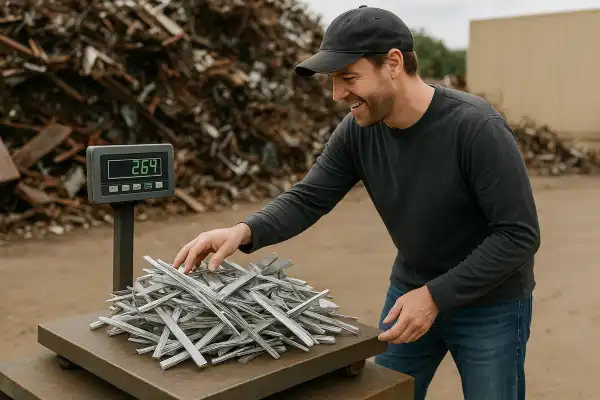Industrial efficiency and environmental responsibility intersect at an interesting point when examining aluminum recycling markets. Is aluminum scrap metal worth anything? This question surfaces regularly among contractors, hobbyists, and industry professionals who encounter aluminum materials in their daily operations. Having spent over a decade processing various metal streams through industrial recycling facilities, I’ve witnessed firsthand how aluminum’s unique properties create consistent value streams that many overlook.
The aluminum market represents one of the most stable segments in scrap metal recycling, driven by the metal’s infinite recyclability and energy-efficient reprocessing characteristics. Understanding aluminum’s market dynamics becomes essential for anyone looking to optimize their material recovery operations.
Is aluminum scrap metal worth anything?
Aluminum scrap metal holds significant value, with current market prices ranging from approximately $0.65 to $0.80 per pound depending on grade and purity. The demand for aluminum has risen in recent years, with projections showing global aluminum demand will increase by almost 40% by 2030. This sustained demand creates reliable value for aluminum scrap across multiple grades and applications.

Current aluminum scrap pricing structure
Market prices vary significantly based on aluminum type, with aluminum EC wire fetching around $0.80 per pound, while 6061 sheet/plate/clip grades command approximately $0.65 per pound. Common aluminum categories include pop cans (free of foil, tin, plastic, and liquid), clean aluminum siding, aluminum turnings, and various extrusion grades. Each category receives different pricing based on processing requirements and end-market applications.
The pricing differential reflects processing costs and contamination levels. Clean and dry aluminum typically commands higher prices from scrap yards, while contaminated materials receive reduced rates. Professional scrappers understand this dynamic and invest time in proper sorting and cleaning procedures to maximize returns.
Factors determining aluminum scrap value
Purity and contamination levels
The purity of scrap aluminum plays a crucial role in pricing, with higher purity materials fetching premium rates. The presence of impurities such as paint, oil, or other metals can lower the purity of the alloy and decrease its value. Material preparation becomes critical for maximizing returns, requiring proper sorting and cleaning before delivery to recycling facilities.
Market demand fluctuations
Aluminum pricing fluctuates much like the stock market, determined by supply and demand dynamics. The global COVID-19 pandemic affected aluminum industries, with sudden growth in demand for home cooking leaving producers scrambling for packaging materials. Recent supply chain disruptions, including jammed shipping ports and Chinese production cutbacks, have contributed to aluminum reaching 13-year price highs.
Grade classification systems
Different aluminum grades command varying prices based on their chemical composition and intended applications. The most common alloys found in scrap are 6061 and 6063, widely used in construction, automotive, and aerospace industries, with scrap values typically ranging from $0.30 to $0.60 per pound depending on market conditions. Understanding grade classifications helps optimize material sorting strategies.
Types of valuable aluminum scrap
Aluminum cans and beverage containers
Aluminum cans represent one of the most recognizable scrap categories, requiring materials to be free of foil, tin, plastic, liquid, and garbage. Recyclers accept both crushed and whole soda cans. The consistency and purity of beverage cans make them highly desirable for recycling operations.
Wire and electrical components
Aluminum EC wire commands premium pricing at approximately $0.80 per pound, reflecting the high purity and easy processing characteristics of electrical-grade aluminum. Proper preparation involves removing insulation and ensuring minimal contamination.
Architectural and construction materials
Clean aluminum siding represents another valuable category, requiring materials to be free from iron, plastic, glass, or other attachments. Construction-grade aluminum includes window frames, door frames, and structural components that maintain good value when properly prepared.
Industrial and automotive scrap
Auto rims and wheels command specific pricing, requiring removal of rubber tires, dirt, lead wheel weights, and attachments. Industrial applications generate high-grade aluminum through machining operations, producing turnings and shavings that maintain excellent recycling value.
Market trends affecting aluminum values
Global supply chain considerations
Trade flows are changing, with China flipping from a net exporter to a net importer of primary and alloyed aluminum for the first time since 2009. Shipping containers remain in short supply, and major ports face congestion, making aluminum transport challenging. These logistical constraints support higher domestic scrap values.
Environmental regulations and sustainability focus
European aluminum alloy producers face challenges sourcing sufficient scrap feedstock, as strong international demand from countries like China and India diverts substantial volumes away from Europe. The increased utilization of aluminum scrap by primary metal producers, spurred by advancements in processing technology and greener production methods, further constrains availability.
Industrial demand patterns
Current trends in different scrap metal-related industries influence pricing decisions. Construction industry demands, automotive sector requirements, and seasonal variations affect aluminum values throughout the year. Understanding these patterns helps optimize timing for material sales.
Maximizing aluminum scrap returns
Proper preparation techniques
Sorting aluminum by type and grade makes processing easier for scrap yards and helps achieve better pricing. Clean and dry aluminum preparation typically results in higher payments. Professional preparation involves removing attachments, cleaning contaminants, and organizing materials by grade.
Volume considerations
Volume and weight influence scrap metal returns, with larger quantities typically commanding better pricing. More scrap metal sold simultaneously rather than in smaller batches improves transaction efficiency. Accumulating sufficient quantities before sale optimizes transportation costs and negotiating position.
Market timing strategies
Scrap metal prices tend to increase when weather conditions improve, as construction and automotive companies become busier and require more materials. When temperatures drop, business typically slows for these industries. Understanding seasonal patterns helps optimize selling timing.
Conclusion
The aluminum sector will need to produce additional aluminum to meet demand growth across all industrial sectors, ensuring continued value for scrap materials. During my recent facility audit at a regional processing center, I observed automated sorting systems separating aluminum grades with remarkable precision, demonstrating how technological advancement supports market efficiency. The combination of strong global demand, supply chain constraints, and aluminum’s infinite recyclability creates a foundation for sustained scrap value. Professional metal processors who understand grade classifications, preparation requirements, and market timing consistently achieve optimal returns from their aluminum recovery operations.
